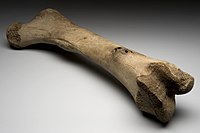
Photo from wikipedia
The treatment of traumatic wounds with exposed bone or tendons is often challenging. An induced membrane (IM) is used to reconstruct bone defects, as it provides an effective and sufficient… Click to show full abstract
The treatment of traumatic wounds with exposed bone or tendons is often challenging. An induced membrane (IM) is used to reconstruct bone defects, as it provides an effective and sufficient blood supply for bone and soft‐tissue reconstruction. This study explored a novel two‐stage strategy for wound management, consisting of initial wound coverage with polymethyl methacrylate (PMMA) and an autologous split‐thickness skin graft under the IM. Fifty inpatients were enrolled from December 2016 to December 2019. Each patient underwent reconstruction according to a two‐stage process. In the first stage, the defect area was thoroughly debrided, and the freshly treated wound was then covered using PMMA cement. After 4‐6 weeks, during the second stage, the PMMA cement was removed to reveal an IM covering the exposed bone and tendon. An autologous split‐thickness skin graft was then performed. Haematoxylin and eosin (H&E) staining and immunohistochemical analysis of vascular endothelial growth factor (VEGF), CD31 and CD34 were used to evaluate the IM and compare it with the normal periosteal membrane (PM). The psychological status and the Lower Extremity Function Scale (LEFS) as well as any complications were recorded at follow‐up. We found that all skin grafts survived and evidenced no necrosis or infection. H&E staining revealed vascularised tissue in the IM, and immunohistochemistry showed a larger number of VEGF‐, CD31‐ and CD34‐positive cells in the IM than in the normal PM. The duration of healing in the group was 5.40 ± 1.32 months with a mean number of debridement procedures of 1.92 ± 0.60. There were two patients with reulceration in the group. The self‐rating anxiety scale scores ranged from 35 to 60 (mean 48.02 ± 8.12). Postoperatively, the LEFS score was 50.10 ± 9.77. Finally, our strategy for the management of a non‐healing wound in the lower extremities, consisting of an IM in combination with skin grafting, was effective, especially in cases in which bony structures were exposed in the elderly. The morbidity rate was low.
Journal Title: International Wound Journal
Year Published: 2022
Link to full text (if available)
Share on Social Media: Sign Up to like & get
recommendations!